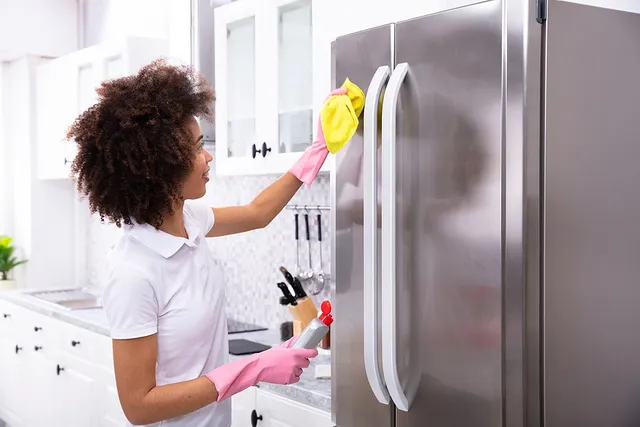The refrigerator is an essential household appliance that most of us depend on to keep our food at a safe temperature 24 hours a day, 365 days a year. The refrigerator’s efficiency allows us to have food for meals and snacks and cool drinks on demand.
Important cleaning tasks should be done regularly to keep the food in the refrigerator cold and safe to eat. Some of these tasks should be done daily or weekly, while others can be done less frequently.
Keeping the fridge clean is vital because a clean and sanitized refrigerator is less likely to harbor dangerous bacteria that can cause illness. Some bacteria, notably, Listeria monocytogenes can thrive and multiply in cold refrigerator temperatures (Food Safety and Inspection Service, 2015).
Keeping the refrigerator clean can seem overwhelming, but there are simple steps you can take to minimize the work of keeping it fresh. Generally, clean the refrigerator unit with dishwashing liquid or baking soda and water on the inside. After they are clean, sanitize removable parts such as shelves and drawers outside of the refrigerator.
Family members go into the refrigerator several times during busy days when they are home and doing a lot of eating and cooking. To keep the fridge from getting messy, wipe up any spills that occur right away. If spills are cleaned when they happen, you can prevent a sticky mess from collecting on the shelves or in the bends.
Spills should be cleaned with warm soapy water and then rinsed with clear water (Robinson, 2018). Avoid using any cleaning solvents in the refrigerator because they could release chemical fumes that can transfer into food and ice, making them unsafe to eat. Dishwashing liquid and water work well to clean the interior of the refrigerator. If you need to eliminate any odors, use baking soda and water.
Use these steps for cleaning and sanitizing refrigerator shelves and drawers (Peterson-Vangsness et al., 2018):
- Remove all refrigerator shelves and drawers.
- Wash the shelves and drawers in water and liquid dishwashing soap.
- Rinse well and sanitize. Sanitizing is the process of reducing microorganisms to safe levels on a surface using heat or chemicals. A simple sanitizer appropriate for use on removable parts of a refrigerator can be made by mixing ¼ teaspoon of unscented chlorine bleach with 2 cups of warm water. This, easy to make sanitizer can be mixed in a spray bottle to use on surfaces after cleaning (McDonald, 2020).
- Once washed and sanitized, air dry shelves and drawers before returning them to the unit.
Once the shelves and drawers are clean, wipe the interior walls of the refrigerator and the gasket with warm soapy water and rinse them with clear water.
To keep the refrigerator smelling fresh, place an open box of baking soda on a shelf in the unit (Yucienco, 2021). Manage the storage times of foods in the refrigerator by making it a habit of throwing out perishable foods that should no longer be eaten. A general rule of thumb for cooked leftovers is to keep the food in the refrigerator for no more than four days. The refrigerator should maintain a temperature of 40°F or below to keep food at a safe temperature.
The exterior of the refrigerator should be cleaned using water and dishwashing liquid. Be sure to keep the refrigerator coils and front grill free of lint by vacuuming it every 3-4 months to keep it working efficiently (Peterson-Vangsness, et al., 2018).
The refrigerator is one of the most useful appliances in the kitchen. A nice tidy refrigerator should be part of your checklist for a clean and safe kitchen.
References:
Food Safety and Inspection Service. (2015). Refrigeration & food safety. U.S. Department of Agriculture.
McDonald, S. (2020, March). Cleaning, sanitizing and disinfecting in the home. Penn State Extension.
Robinson, T. (2018, April). Spring cleaning checklist should include your fridge and pantry, too. Chow Line. The Ohio State University.
Peterson-Vangsness, G., Botzek-Linn, D., Brandt, K. (2018). A clean kitchen is required for food safety. University of Minnesota Extension.
Yuvienco, P. C. (2021, August). Planning some spring cleaning? A check list for a food-safe pantry and refrigerator. United States Department of Agriculture.
Mandel Smith, MS, RD, LDN
Former Senior Educator
Pennsylvania State University
Source: Penn State Extension

